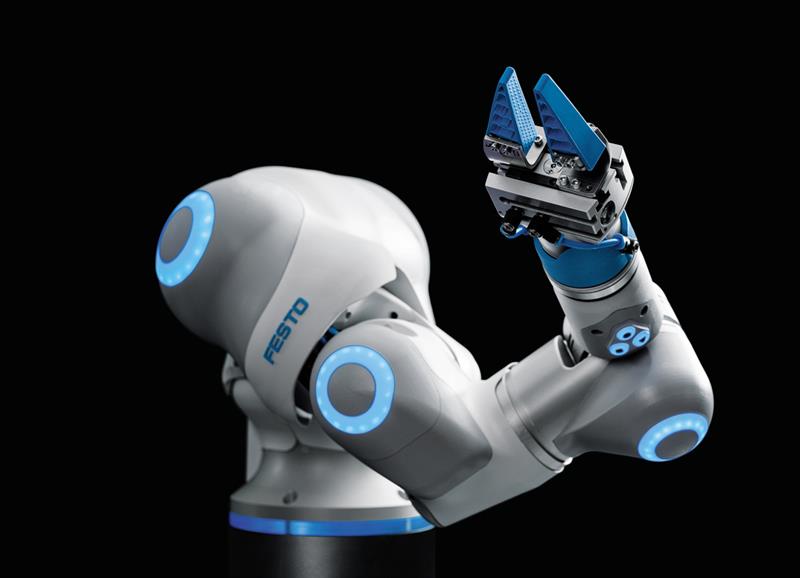As well as their relative inflexibility, cost has been a barrier to widespread adoption; both high initial purchase costs and those associated with programming and tooling. While they often make sense for high volume, high value manufacturing production, small and medium-sized manufacturers with smaller volumes have struggled to justify the expense. The move away from the mass production ethos to more flexible and adaptive manufacture, together with a number of innovations in sensing and vision technologies, is now driving a reassessment of the relationship between man and machine to one based on collaboration, rather than segregation.
Natural progression
Automation technology performs everyday tasks in factories such as gripping, moving and positioning goods and materials. Increasingly, these movements require precision with very small margins for error and a delicacy of touch that traditional industrial robots were never designed to deliver.
Nature performs these tasks instinctively and efficiently, applying just the right amount of force and speed. Festo’s Bionic Learning Network (BLN) is a research, development and innovation alliance that draws inspiration from nature to develop innovative biomimetic technology concepts that have the potential to enhance industrial automation applications. It links the company’s design engineers to renowned universities and institutes, as well as external R&D partners, in a dynamic and open exchange of ideas.
Previous iterations have included bionic ants, dragonflies, jellyfish and penguins. This year’s innovations focus on robotic concepts that are ideally suited for safe human-robot collaboration, due to natural movement patterns and inherently compliant pneumatics. The evolution of these lightweight collaborative robots, or ‘cobots’ offers a safer and more cost-efficient alternative for working in closer proximity with humans.
The BionicCobot is inspired by the natural movement of the human arm; the BionicMotionRobot mimics the way elephant trunks or octopus tentacles move; and the OctopusGripper is modelled on the way they grip.
Biomimetics
 The Bionic Cobot uses precision-controlled closed loop pneumatics in each of its seven joints to emulate the natural movement of the human arm. Its movements can be finely regulated from powerful and dynamic to delicate and yielding using Festo’s Motion Terminal, a digital pneumatics platform combining high-precision mechanics, sensors and complex control. It allows the whole system to rapidly adjust to different dynamic requirements with extreme precision and reliability. Workers are protected as the system can simply ease off in the event of a collision. Operators can also ‘teach’ the BionicCobot actions via an intuitive graphical simulation interface.
The Bionic Cobot uses precision-controlled closed loop pneumatics in each of its seven joints to emulate the natural movement of the human arm. Its movements can be finely regulated from powerful and dynamic to delicate and yielding using Festo’s Motion Terminal, a digital pneumatics platform combining high-precision mechanics, sensors and complex control. It allows the whole system to rapidly adjust to different dynamic requirements with extreme precision and reliability. Workers are protected as the system can simply ease off in the event of a collision. Operators can also ‘teach’ the BionicCobot actions via an intuitive graphical simulation interface.
The BionicMotionRobot features 12° of freedom, emulating the fluent movements of an elephant’s trunk or an octopus’s tentacles by using multiple segments, sturdy elastomer pneumatic bellows and inherently flexible kinematics.
A 3D textile knitted fabric provides an outer skin that enables the force potential of the entire kinematic system to be fully deployed, with a payload of almost 3kg. The textile replaces the rigid metal casings of traditional robots with something more tactile and soft, making contact with humans more forgiving.
The OctopusGripper consists of a pneumatically-controlled soft silicone structure that can bend inwards and wrap around the object to be gripped in a form-fitting and gentle manner. Two rows of actively and passively controlled suction cups increase its ability to pick up and hold a wide range of different objects. Paired with either the BionicMotionRobot or the BionicCobot, it can address a variety of potential gripping applications.
Collaborative working
Advances in computing power and sensor and vision technologies are helping to drive the development of a new generation of more adaptable, lower-cost, lightweight and mobile robots, capable of collaborating more safely with workers on the shop floor. This makes them more compelling for small and medium enterprises, with a lower price entry point, and the flexibility to easily move and reconfigure the robot to address different tasks.
Increasingly in the factories of the future, strict separation between factory workers and industrial robots will give way to collaborative working spaces. On the production lines of tomorrow, humans and machines will be able to safely work together on the same task or process, and this direct interaction between man and machine will be part of the daily routine. Festo’s lightweight bionic robotic concepts, utilising natural movement and the inherent flexibility of pneumatics, are destined for collaborative working spaces and help point the way to this smarter future.
The Bionic Learning Network The Bionic Learning Network (BLN) is about more than just developing new technologies, its innovative principles demonstrate complex ideas in stimulating and enjoyable ways to raise awareness, inspire young people and attract new talent. Exploring the links between nature and technology seeds new strands of innovation, influencing preliminary product development through prototyping and pointing the way for new technologies, applications and potential future products. Its open, interdisciplinary teams help establish networks, encouraging experts and organisations from varied sectors to work with Festo, fostering greater creativity in R&D processes and accelerating development of its design engineering capabilities. BLN Future Concepts combine a wide diversity of technologies and components – including manufacturing concepts, software and control technology. |











